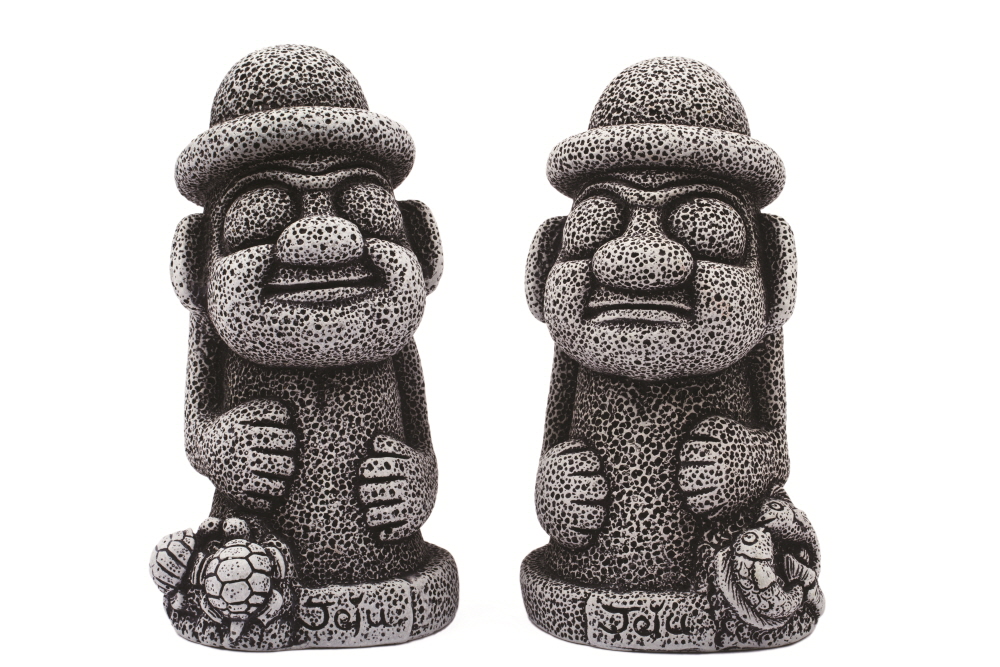제주에서 돌하르방을 만나는 것은 어렵지 않다. 돌하르방은 여행객의 발길이 닿는 곳곳에 자리하며 제주의 대표적인 상징물로서의 역활을 해왔다. 돌하르방이란 ‘돌로 만들어진 할아버지’ 를 뜻하는 제주어다. 석상의 형상이 할아버지의 생김새를 닮았다고 불리기 시작한 돌하르방이라는 이름은 1971년 8월 25일 제주특별자치도 민속자료 제2호로 지정되면서 공식명칭이 됐다. 그렇다면 원래 돌하르방의 이름은 무엇이었을까. 사실 돌하르방의 고유명칭은 따로 없다고 봐도 무방하다.
공식명칭이 생기기 이전에 돌하르방은 각기 다른 지역에서 각기 다른 생김새를 가졌다는 이유로 우석목, 무성목, 벅수머리, 돌영감, 수문장, 장군석, 동자석, 망주석, 옹중석 등 다양한 명칭으로 통용돼 왔기 때문이다. 그중 문헌에 기록된 이름은 옹중석(翁仲石)이며 제주도 주민들 대부분은 이를 우석목이라 불렀다. 우석목은 ‘우석(偶石)’ 과 ‘목(木)’ 의 합성어다. 우석목의 木은 제주 민간 집에 출입구 대신 세워두었던 세 개의 기둥을 뜻하는 정주목의 木과 같은 쓰임새다. 특히 조선시대 관청이었던 제주목, 정의현, 대정현의 성문 밖에도 우석목이 있었는데 이는 우석목을 통해 외부 침입을 막고자 함이었다. 그러나 실질적인 침입을 막기보다는, 신앙적 측면에서 외부의 사악함을 방지하고자 하는 의미가 강했다. 다양한 명칭으로 불려온 만큼, 돌하르방의 제작 동기나 시점, 쓰임 등은 정확히 알 수 없는 상태다. 남방 기원설, 제주도 자생설, 몽골 유풍설 등 세 가지 주장이 가장 일반적으로 거론되고 있으나 이 근거를 뚜렷하게 뒷받침할 역사적인 기록이나 장설은 없다. 다만 효종 4년(1653) 이원진이 편찬한 <탐라지>에 따르면 “옹중석(돌하르방)은 제주읍의 성 동·서·남 삼문 밖에 있었고, 영조 30년(1754) 김몽규가 세웠으나, 삼문이 헐림으로 인하여 2기는 관덕정 앞에, 2기는 삼성사 입구로 옮겼다”는 기록이 있다. 돌하르방이 1754년 무렵에도 존재했음을 알 수 있는 대목이다.
현재 돌하르방은 제주시에 21기, 정의와 대정에 각각 12기, 서울에 있는 국립민속박물관에 2기 등 모두 47기가 남아있다. 원래는 48기였으나 1기는 손실됐다. 곳곳에 남아 있는 돌하르방의 민속적인 기원이나 인류사적인 의미를 현재로서 명확하게 파악하기는 어렵다. 그러나 돌하르방이 옛 제주인 탐라의 수호신이자 과거와 현재, 그리고 미래를 연결해주는 제주 고유의 문화유산이라는 사실은 부정할 수 없을것이다. 제주 곳곳에 살아 숨 쉬는 돌하르방을 좀 더 가까이서 보고 싶다면 여행 중간에 북촌 돌하르방 공원에 방문해보는 것도 좋겠다.
The Origins of the Jeju Dol Hareubang
Dol hareubang are a common enough sight on Jeju Island. These iconic symbols of Jeju can easily be found welcoming visitors at each of the island’s tourist destinations. Dol hareubang is Jeju dialect for “stone grandpa,” so called because they resemble old men. The name dol hareubang became the official term for these stone statues on August 25th, 1971, when they were designated Folk Material No. 2 of the Jeju Special Self-Governing Province. Then what were the dol hareubang originally called? In some ways, it is difficult to tell whether there was a specific name for the dol hareubang prior to 1971, when the dol hareubang had a variety of different names due to being scattered across different areas and having different appearances. These names include useongmok, museongmok, beoksumeori, dol yeonggam, sumunjang, janggunseok, dongja-seok, mangjuseok, and ongjungseok, all of which seem to have been used interchangeably to refer to what we now know as dol hareubang. The name ongjungseok (翁仲石) appears in official records, but most Jeju islanders seem to have called this type of statue useongmok. Useongmok is a compound formed from the words useok (偶石) and mok (木). We find a similar usage of the character 木 which stands for “tree” in the term jeongjumok, the three wooden columns erected in front of houses on Jeju Island to act as de facto entrances. The gates of Jeju-mok, Jeongui-hyeon, and Daejeong-hyeon, which served as government offices during the Joseon Dynasty, were guarded by useongmok to prevent outside invasion. However, the useongmok were believed to provide spiritual protection against evil spirits rather than being charged with defeating physical intruders. Due to such variance in the names used to refer to dol hareubang, it is difficult to determine the exact purpose, age, and use of these stone statues. To date, there are largely three explanations as to how the dol hareubang came to be part of Jeju culture. One contends that the dol hareubang are native to Jeju Island, while the others view them as having come from southeast Asia or the Mongols. Nevertheless, we do know that dol hareubang existed as early as 1754. The Tamnaji, first compiled by Wonjin Lee in the fourth year of King Hyojong’s reign (1653), attests to this fact as follows.
“The ongjungseok (dol hareubang) were raised in the 30th year of King Yeongjo’s reign (1754) by Monggyu Kim and positioned at the eastern, western, and southern gates of the town of Jeju. However, after the three gates were demolished, two of the ongjungseok were moved in front of Gwandeokjeong and the other two to the entrance of Samseongsa.” There are currently 47 dol hareubang in Korea–21 in Jeju City, 12 each at Jeongui and Daejeong, and two at the National Folk Museum of Korea in Seoul–one dol hareubang out of the original 48 having been damaged. Though dol hareubang dot the entire island of Jeju, their folkloric origins and historical significance remain unclear. However, these statues, once the patron gods of old Jeju, now stand as a cultural heritage that not only bridges the past and the present but will lead the island into the future. Those interested in seeing the dol hareubang up close are encouraged to visit the Dolharbang Park in Bukchon during their visit to Jeju Island.
Writer 김대현 Translator 오은지

